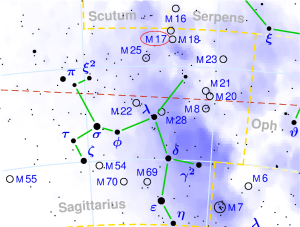The Omega Nebula, also known as Messier 17 (M17), is a bright emission nebula located in Sagittarius constellation. It was named Omega for its resemblance to the Greek letter omega, Ω.
The nebula has the designation NGC 6618 in the New General Catalogue. It is also known as the Swan Nebula, Horseshoe Nebula, Lobster Nebula, or Checkmark Nebula.
Messier 17 is a star forming region with an open cluster, and it is part of a larger cloud of molecular gas found in the direction of Sagittarius.
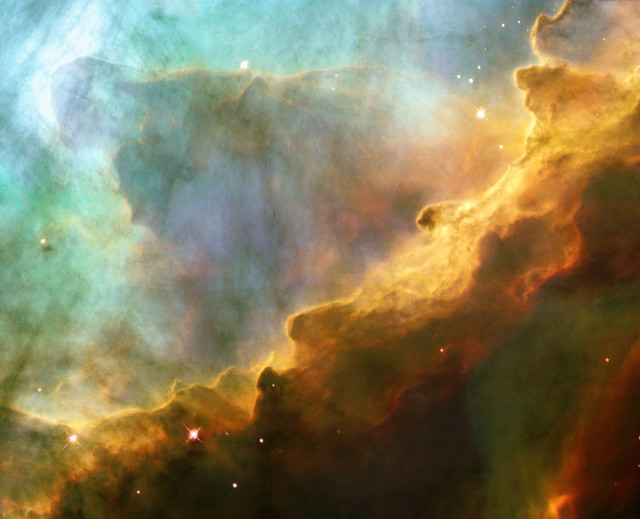
The photograph, taken by NASA’s Hubble Space Telescope, captures a small region within M17, a hotbed of star formation. M17, also known as the Omega or Swan Nebula, is located about 5500 light-years away in the constellation Sagittarius. The wave-like patterns of gas have been sculpted and illuminated by a flow of ultraviolet radiation from young, massive stars, which lie outside the picture to the upper left. The glow of these patterns accentuates the three-dimensional structure of the gases. The ultraviolet radiation is carving and heating the surfaces of cold hydrogen gas clouds. The warmed surfaces glow orange and red in this photograph. The intense heat and pressure cause some material to move away from those surfaces, creating the glowing veil of even hotter greenish gas that masks background structures. The pressure on the tips of the waves may trigger new star formation within them. The image, roughly 3 light-years across, was taken May 29-30, 1999, with the Wide Field Planetary Camera 2. The colors in the image represent various gases. Red represents sulfur; green, hydrogen; and blue, oxygen. Image: NASA, ESA and J. Hester (ASU)
The Omega Nebula lies at a distance between 5,000 and 6,000 light years from Earth, a bit closer to us than M17’s larger neighbour, the Eagle Nebula (Messier 16).
M17 is one of the brightest, most massive star-forming regions in our galaxy. It has a diameter spanning about 15 light years. It is illuminated by 35 hot, young stars that form an open cluster, embedded within the nebula.
The Omega Nebula is part of a larger cloud which is about 40 light years in diameter. The nebula has an estimated mass of 800 solar masses, while the cloud has approximately 30,000 solar masses.
Messier 17 lies in the Sagittarius arm of the Milky Way Galaxy, also known as the Sagittarius-Carina arm. It has a geometry similar to the famous Orion Nebula (Messier 42), but unlike M42, which appears face-on when observed from Earth, the Omega Nebula appears edge-on.
The Omega Nebula’s reddish colour is the result of hot hydrogen gas being illuminated by newly formed stars in the nebula. M17 contains a large amount of dark obscuring material, which is also heated by the hot young stars, and can be seen in infrared wavelengths.
The Omega Nebula contains up to 800 stars in total. About a hundred of them belong to a spectral class earlier than B9, while nine of them are type O stars. There are also more than a thousand stars being formed in the nebula’s outer regions. M17 contains far more newly formed stars than the Orion Nebula. The stars in the Omega Nebula do not readily appear in optical images, but are hidden within the nebula.
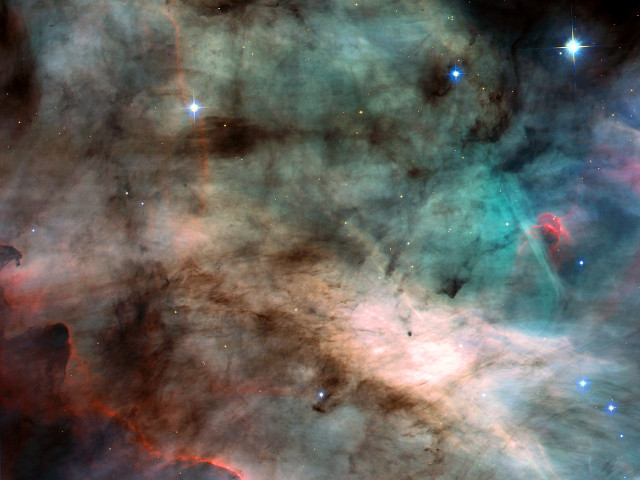
This image shows the center of the Swan Nebula, or M 17, a hotbed of newly born stars wrapped in colorful blankets of glowing gas and cradled in an enormous cold, dark hydrogen cloud. This stunning picture was taken by the newly installed Advanced Camera for Surveys (ACS) aboard the NASA/ESA Hubble Space Telescope. Image: NASA, Holland Ford (JHU), the ACS Science Team and ESA
The 35 young, massive stars responsible for the nebula’s glow are each 20 to 30 times more massive than the Sun and about six times hotter. Their ultraviolet radiation erodes the dense cloud in which they were formed. The cold hydrogen gas clouds are heated and shaped by the radiation, and the pressure causes some of the material on the surfaces of the clouds to move away, creating an intricate structure than obscures the clouds in the background.
The nebula’s glowing gas will eventually be completely eaten away by the radiation of the newly formed stars and leave behind a small open cluster.
The open cluster within the nebulosity is one of the youngest open clusters known. It has an estimated age of just 1 million years. A star designated HD 168607, a luminous blue variable (LBV), is believed to be associated with it, as is the nearby HD 16825, a blue hypergiant.
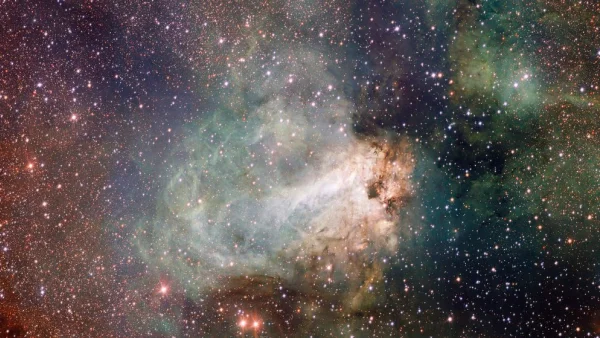
The first released VST image shows the spectacular star-forming region Messier 17, also known as the Omega Nebula or the Swan Nebula, as it has never been seen before. This vast region of gas, dust and hot young stars lies in the heart of the Milky Way in the constellation of Sagittarius (The Archer). The VST field of view is so large that the entire nebula, including its fainter outer parts, is captured — and retains its superb sharpness across the entire image. The data were processed using the Astro-WISE software system developed by E.A. Valentijn and collaborators at Groningen and elsewhere. Image: ESO/INAF-VST/OmegaCAM. Acknowledgement: OmegaCen/Astro-WISE/Kapteyn Institute
Messier 17 can be seen without binoculars in good viewing conditions from locations that aren’t too far north. It is located roughly 10 degrees north of the Teapot asterism, and roughly at the same distance from two other famous nebulae in Sagittarius, the Lagoon Nebula (Messier 8) and the Trifid Nebula (Messier 20).
M17 can easily be found in binoculars by starting from Lambda Sagittarii, the star marking the lid of the Teapot, and moving north, past the Sagittarius Star Cloud (Messier 24). The small open cluster Messier 18 is a degree to the north and Messier 17 lies another degree to the north. It is bright enough to be seen even with moderate amounts of light pollution.
The Omega Nebula can also be found by first identifying Gamma Scuti, a magnitude 4.70 star in Scutum constellation.
M17 lies just over 2 degrees to the southwest of the star. Gamma Scuti can be found by following a line from the bright Altair in Aquila constellation through Delta and Lambda Aquilae.
For observers in northern latitudes, the Omega Nebula is one of the three finest emission nebulae that can be seen in a small telescope, along with the Lagoon Nebula (Messier 8), also in Sagittarius, and the Orion Nebula (Messier 42) in Orion.
Facts
The Omega Nebula was discovered by the Swiss astronomer Philippe Loys de Chéseaux in 1745. It is one of only six nebulae included in his catalogue.
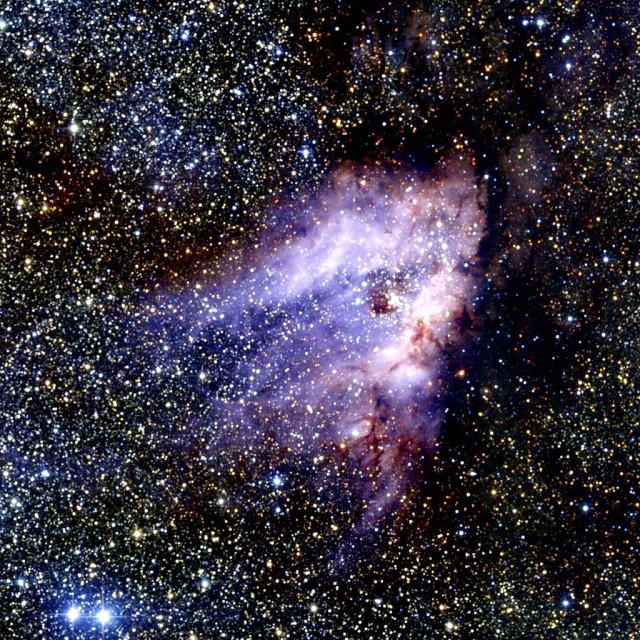
Messier 17. Image: Two Micron All Sky Survey (2MASS), a joint project of the University of Massachusetts and the Infrared Processing and Analysis Center/California Institute of Technology, funded by the National Aeronautics and Space Administration and the National Science Foundation.
After discovering the nebula, de Chéseaux noted, “It is of a completely different shape than the others: It has perfectly the form of a ray, or of the tail of a comet, of 7′ length and 2′ broadth; its sides are exactly parallel and rather well terminated, as are its two ends.”
The nebula was catalogued by Charles Messier, who discovered it independently, on June 3, 1764. Messier described the object as a “train of light without stars, of 5 or 6 minutes in extent, in the shape of a spindle, & a little like that in Andromeda’s belt [Messier 31] but of a very faint light; there are two telescopic stars nearby & placed parallel to the equator. In a good sky one observes this nebula very well in an ordinary telescope of 3.5-foot.”
John Herschel made a drawing of the nebula in 1833, as part of a series of sketches, published in 1836. He described the figure of the nebula as “nearly that of a Greek capital omega, Ω, somewhat distorted, and very unequally bright.”
Others who have sketched the nebula include William Lassell in 1862, who used a 4-foot telescope at Malta and Edward Singleton Holden in 1875, using the 26-inch Clark refractor at the U.S. Naval Observatory.
Omega Nebula – Messier 17
Constellation: Sagittarius
Coordinates: 18h 20m 26s (right ascension), -16°10’36” (declination)
Distance: 5,000 to 6,000 light years
Apparent magnitude: 6.0
Apparent dimensions: 11 arcminutes
Angular size: 20′ x 15′
Designations: Omega Nebula, Messier 17, NGC 6618, Swan Nebula, Horseshoe Nebula, Lobster Nebula, Checkmark Nebula, RCW 160, Sharpless 45, Gum 81
Images
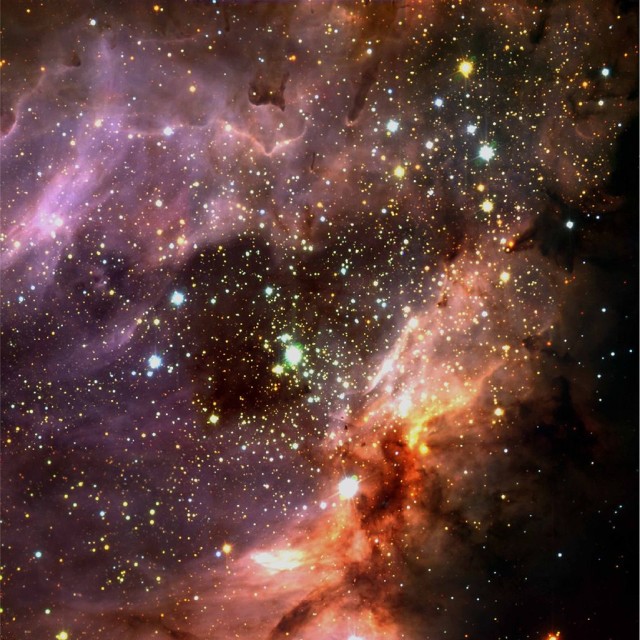
Three-colour composite of the sky region of M 17, a H II region excited by a cluster of young, hot stars. A large silhouette disc has been found to the south-west of the cluster centre. The present image was obtained with the ISAAC near-infrared instrument at the 8.2-m VLT ANTU telescope at Paranal. Image: ESO
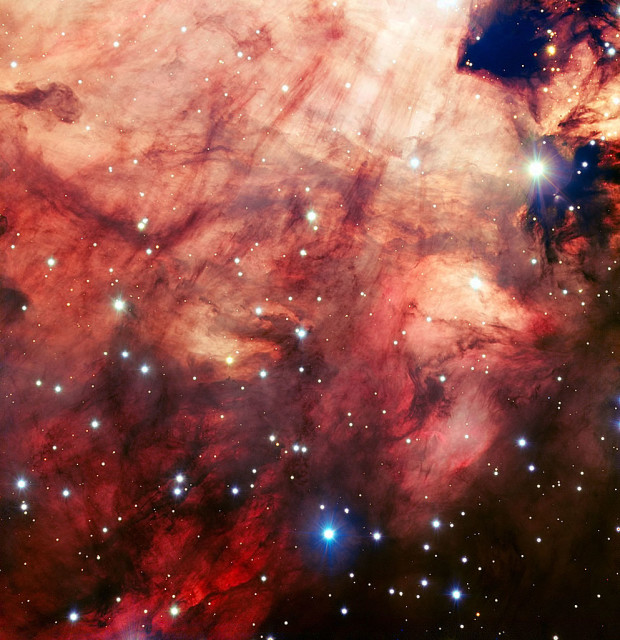
This image of the Omega Nebula (Messier 17), captured by ESO’s Very Large Telescope (VLT), is one of the sharpest of this object ever taken from the ground. It shows the dusty, rosy central parts of the famous star-forming region in fine detail. Image: ESO
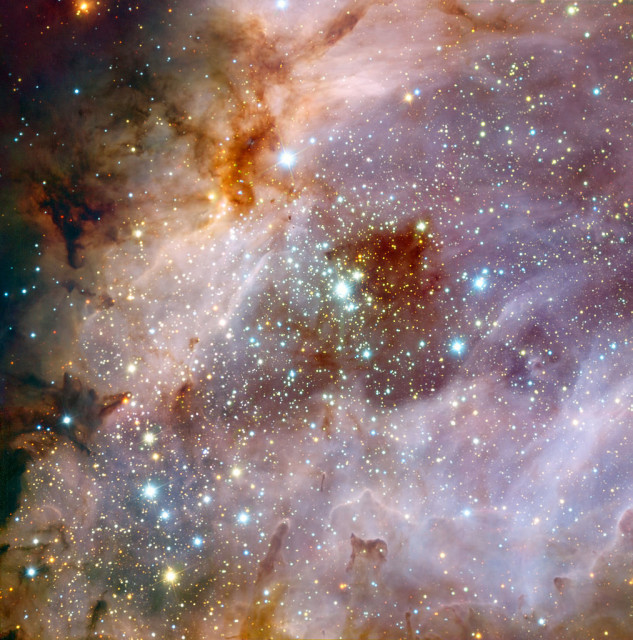
Astronomers using data from ESO’s Very Large Telescope (VLT), at the Paranal Observatory in Chile, have made an impressive composite of the nebula Messier 17, also known as the Omega Nebula or the Swan Nebula. The painting-like image shows vast clouds of gas and dust illuminated by the intense radiation from young stars. The image shows a central region about 15 light-years across, although the entire nebula is even larger, about 40 light-years in total. Messier 17 is in the constellation of Sagittarius (the Archer), about 6000 light-years from Earth. It is a popular target for amateur astronomers, who can obtain good quality images using small telescopes. These deep VLT observations were made at near-infrared wavelengths with the ISAAC instrument. The filters used were J (1.25 µm, shown in blue), H (1.6 µm, shown in green), and K (2.2 µm, shown in red). In the centre of the image is a cluster of massive young stars whose intense radiation makes the surrounding hydrogen gas glow. To the lower right of the cluster is a huge cloud of molecular gas. At visible wavelengths, dust grains in the cloud obscure our view, but by observing in infrared light, the glow of the hydrogen gas behind the cloud can be seen shining faintly through. Hidden in this region, which has a dark reddish appearance, the astronomers found the opaque silhouette of a disc of gas and dust. Although it is small in this image, the disc has a diameter of about 20 000 AU, dwarfing our Solar System (1 AU is the distance between the Earth and the Sun). It is thought that this disc is rotating and feeding material onto a central protostar — an early stage in the formation of a new star. Image: ESO/R. Chini
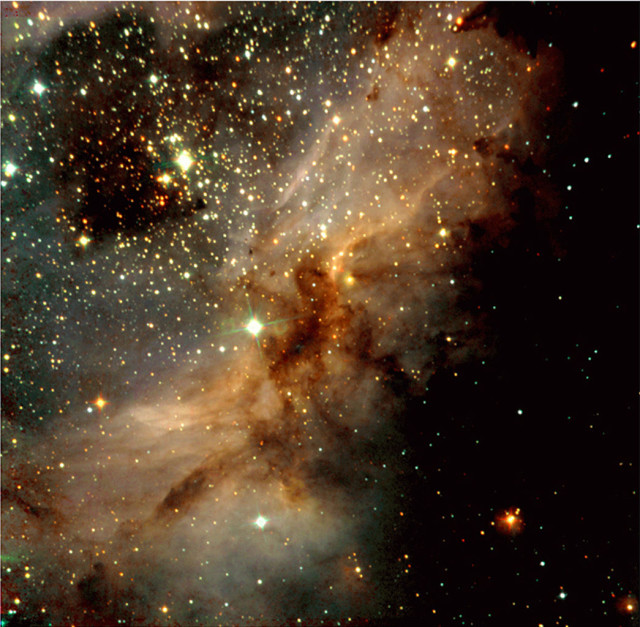
This image is a near-infrared, colour-coded composite image of a sky field in the south-western part of the galactic star-forming region Messier 17 . It is based on exposures obtained on August 15, 2000, with the SOFI multi-mode instrument at the ESO 3.6-m New Technology Telescope (NTT) at La Silla. In this image, young and heavily obscured stars are recognized by their red colour. Bluer objects are either foreground stars or well-developed massive stars whose intense light ionizes the hydrogen in this region. The diffuse light that is visible nearly everywhere in the photo is due to emission from hydrogen atoms that have (re-)combined from protons and electrons. The dark areas are due to obscuration of the light from background objects by large amounts of dust – this effect also causes many of those stars to appear quite red. A cluster of young stars in the upper-left part of the photo, so deeply embedded in the nebula that it is invisible in optical light, is well visible in this infrared image. Technical information : The exposures were made through three filtres, J (at wavelength 1.25 µm; exposure time 5 min; here rendered as blue), H (1.65 µm; 5 min; green) and Ks (2.2 µm; 5 min; red); an additional 15 min was spent on separate sky frames. The seeing was 0.5 – 0.6 arcsec. The objects in the uppermost left corner area appear somewhat elongated because of a colour-dependent aberration introduced at the edge by the large-field optics. Image: ESO
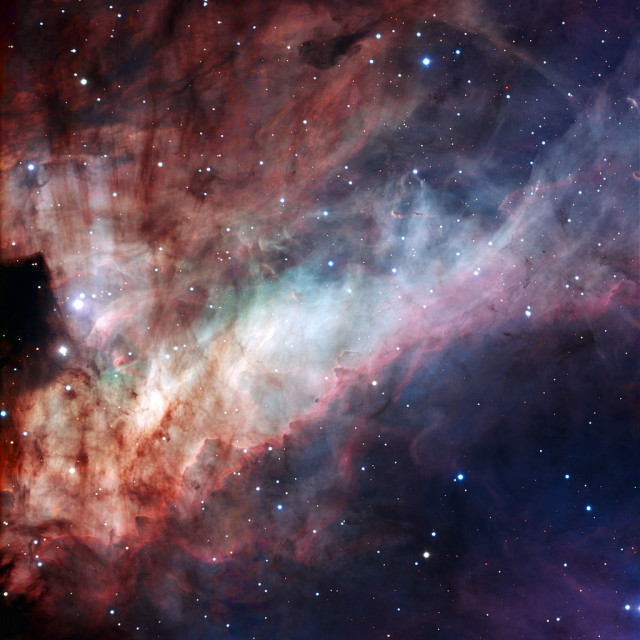
Three-colour composite image of the Omega Nebula (Messier 17, or NGC 6618), based on images obtained with the EMMI instrument on the ESO 3.58-metre New Technology Telescope at the La Silla Observatory. North is down and East is to the right in the image. It spans an angle equal to about one third the diameter of the Full Moon, corresponding to about 15 light-years at the distance of the Omega Nebula. The three filters used are B (blue), V (“visual”, or green) and R (red). Image: ESO
